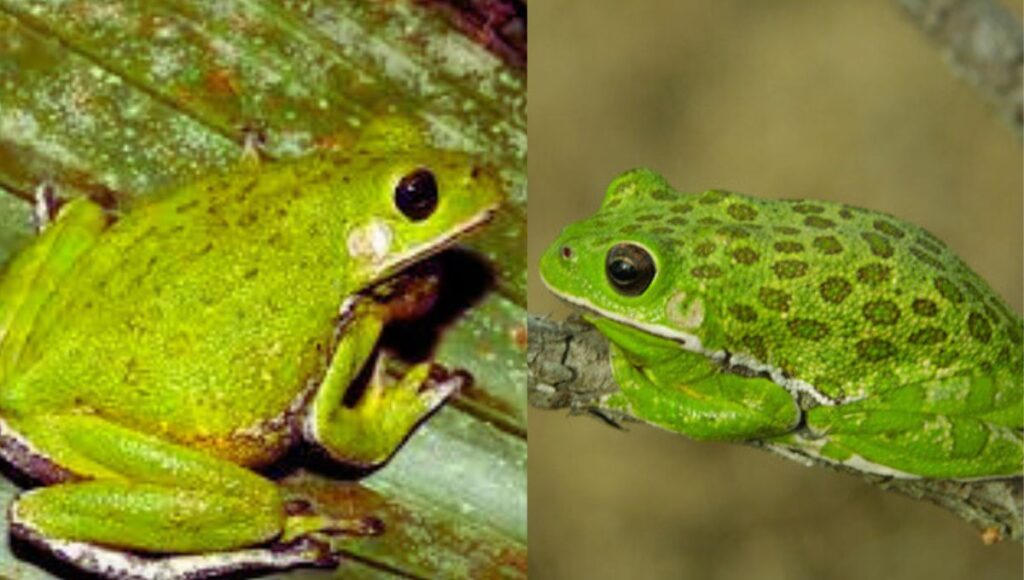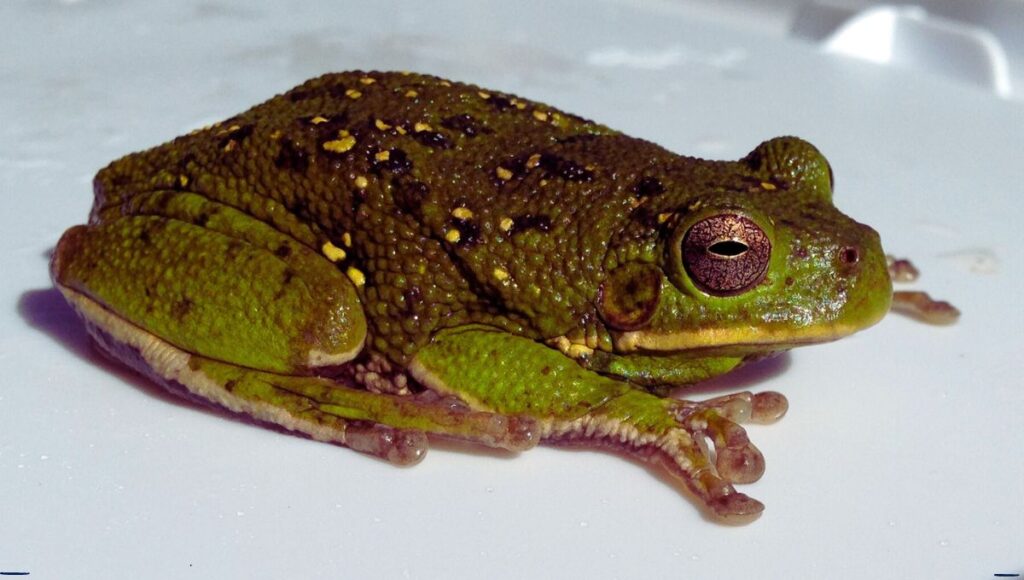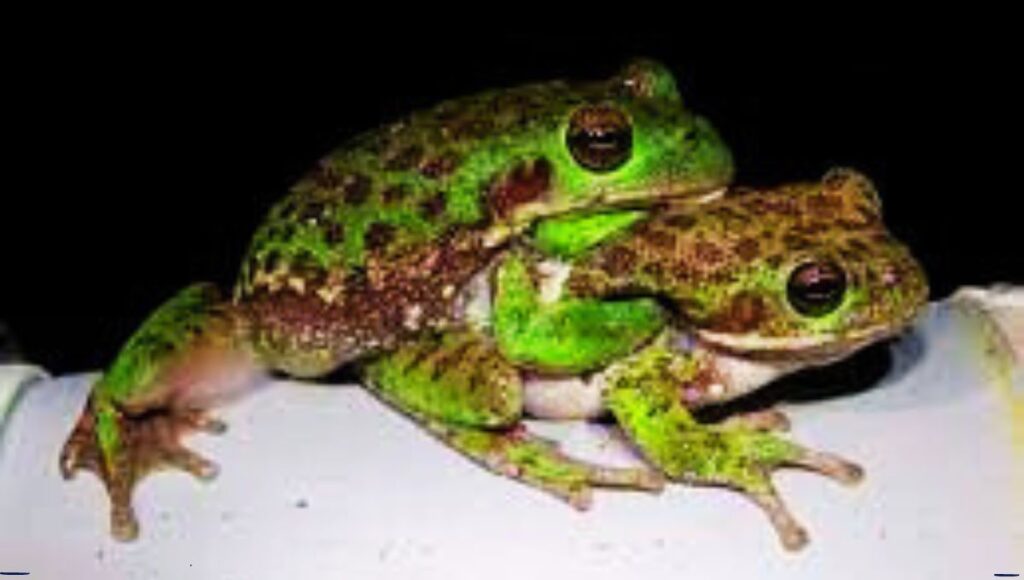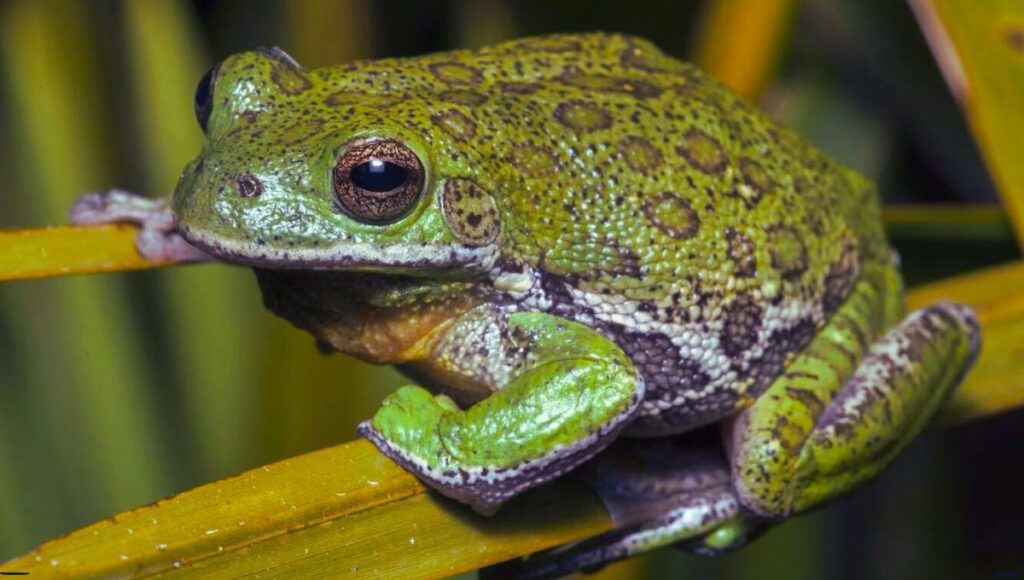Barking tree frogs, also known as Dryophytes gratiosus, are a species of tree frogs known for the sounds they produce that sound like a barking dog. Many pet lovers are interested in keeping them as pets but are Barking tree frogs excellent pets for families or beginners? Let’s find out.

Table of Contents
Everything About Barking Tree Frogs:
In a Glimpse:
| Common Name | Barking Tree Frogs |
| Scientific Name | Dryophytes gratiosus |
| Other Names | N/A |
| Maximum Length | 2-3 inches |
| Maximum Weight | N/A |
| Ranges | North America |
| Habitat | Warm and Moist Environment |
| Diet | Carnivore |
| IUCN Status | Least Concern |
| Lifespan | 5-7 years |
Geographical Range:
These tree frogs are native to the southeastern part of America, from Delaware to southern Florida and eastern Louisiana. Their ranges extend up to Tennessee, Kentucky, and Maryland, where the Barking tree frogs are found in isolated colonies.
Habitat:
Barking tree frogs can survive in both land and water and they are often found in the coastal plains. When the weather is warm, the tree frogs show their arboreal nature and climb to the tree top to avoid the heat. During dry conditions, the frogs also dig into the ground around tree roots to gather moisture.
Breeding Habitat:
During the breeding season, the group of frogs, reside near waterbodies, such as ponds, streams, lakes, and temporary or permanent waterbodies. The male calls the female in an inflated condition from shallow water. After mating, both sexes migrate to the grassland biome.
Physical Description: How do you identify a Barking tree frog?

Barking tree frogs are the largest native tree frogs in the United States and their snout-to-vent length is 2-3 inches (5-7.5 cm) and tadpoles are nearly 2 in or 5 cm in length. The tree frogs have various colour combinations such as bright or dull green, yellow, brown, or grey but they are recognizable due to their dark and round spots (grey and green-yellow markings) on their dorsum. Males have large vocal sacs, light green or yellow throats, and round toe pads that allow them to climb trees quickly.
Sexual dimorphism is not present in these tree frogs as males and females are almost similar in size. The skins of Barking tree frogs are very different from other native American frogs as neither their skins are rough or warty nor smooth. The skin has a granular appearance that changes colour depending on temperature, lighting, time of day, and surroundings or shows camouflage. The eyes of the tree frogs are brown, black, and gold.
Are Barking tree frogs poisonous?
Barking tree frogs are not aggressive or poisonous. They are almost harmless to humans and other animals such as dogs, cats, etc. But the tree frogs are prone to be attacked by Salmonella bacteria that can cause skin irritation to humans. But if the bacteria enter your body, the bacteria can cause infection in urine, blood, nervous system, joints, and bones and also cause other several diseases.
Diet:
Barking tree frogs are carnivorous and opportunistic predators. The tree frogs hunt their prey on the ground as well as on the treetops. In the wild, the frogs consume various types of insects such as crickets, waxworms, spiders, flies, invertebrates, and other smaller frogs.
Predators and Threats:

Barking tree frogs lay 1500-4000 eggs on aquatic vegetation during breeding season. Their eggs and larvae are excellent sources of proteins for fish and other aquatic animals. Adult frogs are also prey for snakes, raccoons, prey birds, badgers, and other mammals in the wild.
The tree frogs are also facing many anthropogenic challenges due to deforestation and encroachment of the forests. Human interventions such as the expansion of agriculture, human settlements, use of pesticides and chemicals, pollution, and also destruction of the waterbodies pose serious threats to the frog species.
Conservation Status:
According to the IUCN Red List of Threatened Species, Barking Tree frogs are listed as “Least Concern” as their population is stable in the wild.
Disease:
Like other amphibians and frog species, Barking tree frogs are also affected by a deadly skin disease which is caused by Chytrid fungus. Also, the frog species can be attacked by Salmonella bacteria which can cause laziness and inactiveness to the tree frogs.
Lifespan:
Barking tree frogs can live up to 5-7 years in the wild. But in captive care, they live 10-12 years, in rare cases till 15 years.
Behaviour:
Barking tree frogs are solitary and nocturnal by nature. They rest all day either on top of the tree or they burrow in the sand to escape the hot environment. When the weather is hot and dry the treefrogs aestivate and in cold weather they hibernate. Both aestivate and hibernate are done around the roots of other vegetation to maintain the moisture level of their body.
Vocalization: Do Barking tree frogs really bark?
The tree frogs use two different sounds to communicate with each other. During mating season, the males call out the females in a loud note from a shallow water body to indicate they are ready to mate. This call is known as “Donk” or “Tonk” and is repeated every 1-2 seconds.

The females also love to pick an attractive mating call unless it is more than 5 meters away. Male frogs with greater amplitude are more likely to find a female partner earlier than others. However, this call is done by chorus and it reduces the time that the males will call in chorus.
The other call is given by the tree frogs when they are on top of the tree. They emit a low-pitch sound that resembles the bark of a dog and it is a call of 9 or 10 harsh syllables. Hence, the Barking tree frogs don’t bark but their sound resembles the barking of a dog.
Apart from vocalizations, the tree frogs use visual signals to perceive their environments. Their sharp eyesight and sensibility help them to detect the environment and if any prey and predators are nearby.
Physical Activity:
The tree frogs often jump in shallow water from the tree branches and also the frogs are not good swimmers. Hence they prefer to sit in shallow water and wait for their partners.
Ecological Impacts:
The Barking tree frogs are insectivorous and they can be used in pest control. Additionally, the frog species helps in aerating the soil by burrowing which helps to maintain the soil health.
Are Barking Tree frogs good pets for families and beginners?
Yes, Barking tree frogs can be great pets for families as well as beginners. The tree frogs are docile, easy to care and low maintenance once their habitats are set up. Unlike many other frogs, these frogs can tolerate human company to a certain extent and even you can feed with using your fingers.
Their activities such as movements, hunting, and other techniques are very entertaining to watch. Additionally, their vocalizations, similar to a barking dog are unique and it may surprise anyone who doesn’t know about this frog species. More importantly, you can cage two or more frogs in a single container, which is not common among frog species.

Also, you need to be careful that the skin of these frogs is very delicate and can tear up if you don’t handle them gently. Barking tree frogs are very sensitive to chemicals, such as soaps, oils, and chlorines. Hence, wash your hands without soap before touching the frogs. Salmonella bacteria are often attached to these tree frogs, if the bacteria come in contact with your skin, may cause irritations. Also, if you have kids, or old people at your home, their sleep at night might get hampered by their low-pitched barking-like sound which is very loud sometimes.
If you are searching for a human-friendly frog, that might company and feed foods from your fingers and communicate with you, Barking tree frogs might be a good choice for you. If you have a family or you are a beginner frog owner, you can still have this frog in your house as they don’t require high maintenance.
How do you buy a Barking tree frog?
First advice, please avoid buying them from illegal pet markets. Because those frogs are often illegally captured and not healthy. It’ll also promote illegal capturing, hunting, and poaching of the tree frogs. Hence, try to buy Barking tree frogs from a reputed breeder or pet shop that can ensure that the frog is born and bred in captivity. Also ask for proof of origin, health certificates, and other important documents before buying the frogs.
It is also important to know the laws regarding the amphibian species in your country or state before you purchase them. If the frog species is not allowed to be kept as pets in your area, you may get into heavy trouble (it is unlikely possible for Barking tree frogs). You can also check online platforms to buy the frogs but check reviews, policies, and other information before.
The price of the frogs depends on their age, sex, health conditions, size, location, and availability. You can expect Barking tree frogs may cost around $12-$60 depending on your location.
Requirements and Care:

Enclosure and Decoration:
A 10-gallon terrarium with a secure lid and proper ventilation system will be perfect for one Barking tree frog. As the frogs are not good swimmers, you may also need a shallow water dish or pond where the frog can sit and drink water without drowning. You’ll also need a few live or artificial plants where the frogs can climb and hide during the daytime and show their arboreal nature.
Can you keep two or more Barking tree frogs in the same tank?
Yes, you can keep but it is advised to keep similar size of Barking tree frogs in the same tank. Cannibalism is not seen yet in the frog species but in rare cases, these tree frogs might show cannibalism. Hence, it is advised to keep similar-sized frogs in a tank. A 20-gallon tank will be perfect for three frogs but the bigger the tank the better for the frogs.
Substrate:
As the Barking tree frogs require humid conditions to thrive, you need substrates that can hold moisture for a long time. During dry seasons, the frogs burrow on the ground to gather moisture. It is advised to have natural substrates such as peat or green moss, coco fibre, or a mixture of coco fibre and orchid barks because these are very efficient in holding the moisture level. The substrates must be 2-3 inches deep as Barking tree frogs love to dig or burrow on the ground.
Temperature and Humidity:
As these frogs are native to Southeastern America, they are more suitable in the tropical rainforest ecosystem. You should try to keep the temperature of the enclosure at 70-75 degrees Fahrenheit during the daytime and a bit cooler during the night. Use a thermometer to detect the temperature of the enclosure and you can use a heat mat or heat lamp to increase the temperature of the tank (if it is cold). But avoid overheating the enclosure, or it’ll make the frogs sick.
Additionally, these tree frogs also require a moderate to high moisture level to thrive (60-80%). Use a hygrometer to monitor the moisture level and make sure the ventilation system of the enclosure is properly working. You can use a fogger or mist maker, or you can simply sprinkle water several times a day to maintain the humidity level.
Lighting:
Like any other frogs or amphibians, Barking tree frogs also require a 12-hour light circle to maintain regular activities. You can use a low-watt fluorescent bulb or UVA/UVB bulbs to provide them with sufficient light. UV bulbs also help them to get some vitamin D that they usually don’t receive from sunlight.
Food and Water:
The carnivorous frog species usually feed on cricket, locusts, spiders, gut-loaded wax worms, mealworms, superworms, fruit flies, and insect larvae. The quantity of their food depends on their age, sex, health condition, and appetite level. You can feed an adult frog with 4–6 crickets every other day to avoid obesity. But you need to feed the tadpoles regularly.
It is recommended to use only dechlorinated water for the Barking tree frogs (from drinking to filling the water dish). Ensure, the water is not polluted or the amount of chlorine is not much in the water. You can collect some fresh rainwater and use them directly. Collect the rainwater after 30 minutes the rain has started to avoid atmospheric pollutants such as Sulfur Dioxide, Nitrous Oxide, and Suspended Particulate Matter that are acidic and harmful to the frogs.
Handling:
Barking tree frogs are human-friendly and they can tolerate human touches. The frogs can sit on your palm and take food from your fingers. They love your attention to some extent and beyond that it may cause stress to them. As their skin is very delicate, handle them carefully and wash your hands before and after touching them. Prevent your kids from touching them and also respect the frog’s personal space and choice.
Cleaning:
You must clean the water dish, waste foods, and dead insects regularly to prevent bacterial growth, otherwise, it will make your frog sick. As Barking tree frogs are prone to attack by Salmonella bacteria, deep clean the tank once a week with a mild disinfectant and rinse it thoroughly with dechlorinated water. Also, You can change the substrate whenever it is necessary (usually in 10-12 weeks).
With proper environment and captive care, Barking can live up to 15 years. Hence, care for your frogs as much as you can to give them a longer life.
FAQs:
Do Barking tree frogs change colour?
Yes, similar to other tree frogs, Barking tree frogs can show camouflage or they can change colour depending on the surroundings and situations. These tree frogs can change the colour from green to gray and brown which helps them avoid predators and hunt prey.
Reference: Wikipedia
Also Read: Are Pickerel Frogs Good Pets for Beginners? Everything About the Alluring Creature
Also Read: Is American Bullfrog Banned as Pet? Top 11 Differences with African Bullfrog